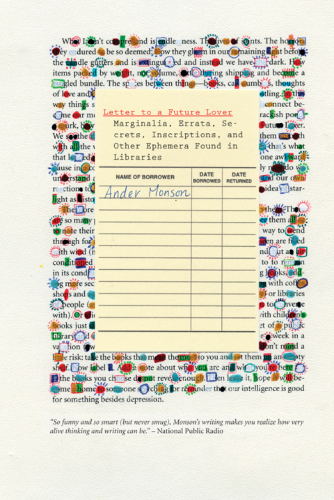
Letter to a Future Lover
Marginalia, Errata, Secrets, Inscriptions, and Other Ephemera Found in Libraries
کتاب های مرتبط
- اطلاعات
- نقد و بررسی
- دیدگاه کاربران
نقد و بررسی

December 8, 2014
In his highly quirky, sometimes frustrating collection of short essays, Monson reflects on the communal experience of reading books in libraries and on the nature of libraries themselves. He recalls the pleasures of card catalogues and wonders which books were stored in a now-empty library. He makes the point that the voices that speak to us from books are not always the ones the author intended; sometimes readers leave comments in a book’s margins, or pieces of paper between its pages. One of the more intriguing and effective essays is his open letter to those who have defaced books with their own bigoted or outraged commentary. Most of his pieces began life as ephemera themselves, with Monson leaving them in library books. There are moments of insight and delight, and the idea of exploring literally marginal writings is a bright one, but Monson’s idiosyncratic presentation and prose style can be exasperating, walking a fine line between self-reflection and self-indulgence. The essays are offered alphabetically, and the author’s advice (given in the second essay, “AI”) is to dive right in and read them in whatever order one wishes. In this respect, his book is gracious and respectful toward its intended readers, even if it may prove inaccessible to some of them. Illus.

December 1, 2014
Short essays on libraries, literature and life.As an eclectic writer, editor and academic, Monson (Nonfiction/Univ. of Arizona; Vanishing Point: Not a Memoir, 2010, etc.) defies conventional continuity to make leaps of connection, not only between paragraphs, but even within a sentence. He continues to challenge the very meaning of meaning, daring readers to come to terms with "the book, the book about the book," and the very concept of the library, be it public, prison, personal, seed, digital or abandoned and repurposed. "A library is a synonym for slow, a silent coil into the past's dust," he writes. "Quick transmission of anything here won't get you anywhere." Monson writes of the future reader, even lover, with whom he connects through a book and of the life that you leave behind, not merely in the books that you've written, but the ones you've read: "You get at least two afterlives. One resides in memory, not yours, but another's. You don't get to choose whose. The other is in the disposition and dispersion of your books." These essays are more often playful than impenetrable, though they defy easy paraphrase or analysis. The author suggests early on that readers start with the section called "How to Read a Book," which he places in the middle of this book and which he begins, "Read this first. Or read this last." He later advises to use the book "like a game. Reading is participation, but I want more of you. So mark it up. Annotate a page. Trade a boring essay with another copy." Each reader will have a different experience with the book, which the author suggests is as much the reader's book as the writer's. Writing that requires a receptive readership as flexible as the prose.
COPYRIGHT(2014) Kirkus Reviews, ALL RIGHTS RESERVED.

September 1, 2014
Triple-threat author Monson's novel Other Electricities won the John C. Zacharis First Book Award; his poetry collection Vacationland won a Tupelo Press Editors' Prize; and Vanishing Point was a National Book Critics Circle finalist in criticism. Here Monson examines the marginalia, highlighting, and more left behind in books from academic libraries to friends' collections as he investigates how reading and writing shape us, our need to annotate and preserve, and the very nature of libraries.
Copyright 2014 Library Journal, LLC Used with permission.

February 15, 2015
In this collection of essays on the secret lives of books, as seen through marginalia, sidenotes, personal collections, and reader histories, Monson (English and creative writing, Univ. of Arizona; Vanishing Point) weaves together thoughts on life, loss, lust, libraries, and everything in between--a celebration of bibliophilia in a neat little package that draws the reader in as it considers the wonder of books and their infinite histories. The "letters" (or essays) can be read in any order, as Monson reminds us, each epistle contains its own subtle bit of wisdom. This is a hard book to describe, packed with information and insight on any number of topics, from library catalogs to memory to the days of Biosphere 2. It defies expectation and is much more than memoir or meditation, bringing the reader into an intimate conversation that sparks the imagination with thoughts on what might be. VERDICT As a whole, this experimental and genre-bending work is difficult to categorize for specific readers. It is suitable for academic libraries, particularly those collecting in areas such as creative writing, philosophy, or literary theory, or for readers who enjoy books on the history of the book and libraries in general. [See Prepub Alert, 8/11/14.]--Gricel Dominguez, Florida International Univ. Lib.
Copyright 2015 Library Journal, LLC Used with permission.

























دیدگاه کاربران